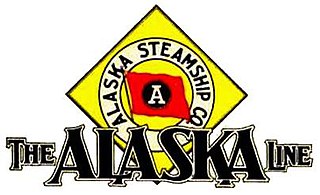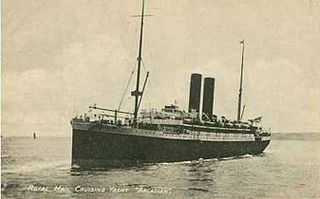
The Pacific Mail Steamship Company was founded April 18, 1848, as a joint stock company under the laws of the State of New York by a group of New York City merchants. Incorporators included William H. Aspinwall, Edwin Bartlett, Henry Chauncey, Mr. Alsop, G.G. Howland and S.S. Howland. These merchants had acquired the right to transport mail under contract from the United States Government from the Isthmus of Panama to California awarded in 1847 to one Arnold Harris.

The Illawarra Steam Navigation Company was a shipping company that serviced the south coast of New South Wales, Australia from 1858 to the early 1950s. It was formed through the amalgamation of the General Steam Navigation Company, the Kiama Steam Navigation Company and the Shoalhaven Steam Navigation Company, each of whom serviced parts of the south coast with their respective vessels. After merging, the new company held a near monopoly in regard to shipping on the south coast, and their fleet visited every significant port between Sydney and the border of Victoria. The company transported both passengers and a range of produce, including livestock, and hence it became known as the 'Pig and Whistle Line': it was said that ships would wait an hour for a pig but not a minute for a passenger.

P Henderson & Company, also known as Paddy Henderson, was a ship owning and management company based in Glasgow, Scotland and operating to Burma. Patrick Henderson started business in Glasgow as a merchant at the age of 25 in 1834. He had three brothers. Two were merchants working for an agent in the Italian port of Leghorn; the third, George, was a sea captain with his own ship.

Cory Environmental is a large resource management, recycling and energy recovery company in the United Kingdom. Cory operates in nearly 40 locations throughout England, providing services in the collection, recycling and disposal of waste.
William Hamilton and Company was a British shipyard in Port Glasgow, Scotland. The company was bought by Lithgow Ltd., which later became Scott Lithgow and was nationalised as part of British Shipbuilders in 1977.

The Gas Light and Coke Company, was a company that made and supplied coal gas and coke. The headquarters of the company were located on Horseferry Road in Westminster, London. It is identified as the original company from which British Gas plc is descended.

The Alaska Steamship Company was formed on August 3, 1894. While it originally set out to ship passengers and fishing products, the Alaska Steamship Company began shipping mining equipment, dog sleds, and cattle at the outbreak of the Klondike Gold Rush of 1897. The company was purchased by the Alaska Syndicate and merged with the Northwestern Steamship Company in 1909, but retained its name, and the fleet was expanded to 18 ships. During World War II, the government took over the company's ships. When the war ended, the company struggled to compete with the new Alaska Highway for passengers and freight. It discontinued passenger service altogether in 1954 and shut down operations in 1971.
SS Hsin Wah, now also known as the SS Xinhua, was a steamship owned by China Merchants Steam Navigation Company, navigating between Canton City, Hong Kong, and Shanghai. She was built in 1921 by Napier & Miller in Glasgow. The ship was once seized by pirates of Bias Bay in 1928 and saved by the SS Zhongshan. She sunk in 1929 when grounded on northern rocks of Waglan, an island southeast of Hong Kong Island in Hong Kong, with a loss of between 300 and 400 lives.

SS Olympia was a steamship that served the northwest United States and Alaska during the Klondike Gold Rush. She was wrecked in 1910.

SS Lanthorn was a 2,299 GRT cargo ship built in 1889 as SS Magnus Mail, renamed in 1916 and sunk by enemy action in 1917. She was a combined steamship and two-masted sailing ship.

SS Coptic was a steamship built in 1881, which was successively owned by the Oceanic Steam Navigation Company, the Pacific Mail Steamship Company, and the Japanese Oriental Steam Ship Co. before being scrapped in 1926. She was filmed by Thomas Edison in 1897 in one of his early movies. The movie is currently stored in the Library of Congress, archive.org and other internet archives.

SS Arcadian was a Barrow-in-Furness built passenger liner constructed in 1899 by Vickers, Sons & Maxim Ltd for the Pacific Steam Navigation Company as SS Ortona. In World War I she served with the Royal Navy and was sunk by a U-boat in 1917.

The SS Caracas (1881–1889) was a coastal passenger steamship built by William Cramp & Sons in Philadelphia. She was the older sister ship to the Valencia. Both Caracas and Valencia served from New York City to Venezuela. The short life of Caracas ended in 1889, when she ran aground in Yaquina Bay under the name Yaquina Bay.
Helsingfors was a Finnish freight and passenger steamship built in Belgium in 1903 for Helsingfors Ångfartygs Aktiebolaget. She ran aground and sank near Bengtskär on 1 January 1905. The accident resulted in the construction of the Bengtskär Lighthouse.
The Waldensian was a steamship of the Rennie line that was lost on 13 October 1862 after it ran aground on rocks at Struis Point near Cape Agulhas en route from Durban to Cape Town. The passengers included eight predikants of the Dutch Reformed Church, one of them, the reverend Frans L. Cachet, later writing that it was said on leaving Durban that the ship would not arrive safely, as "one minister aboard a ship is bad enough, but with eight on board, things could not possibly go well." There was no loss of life.











